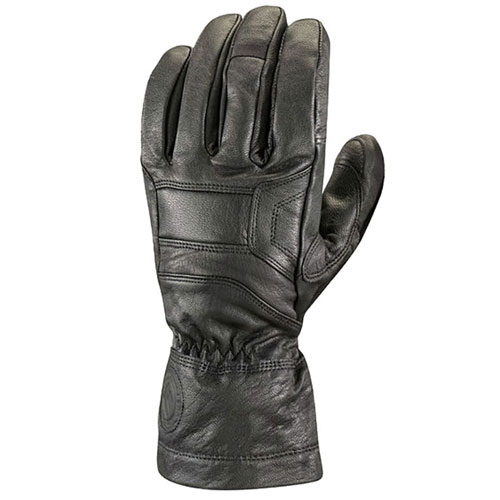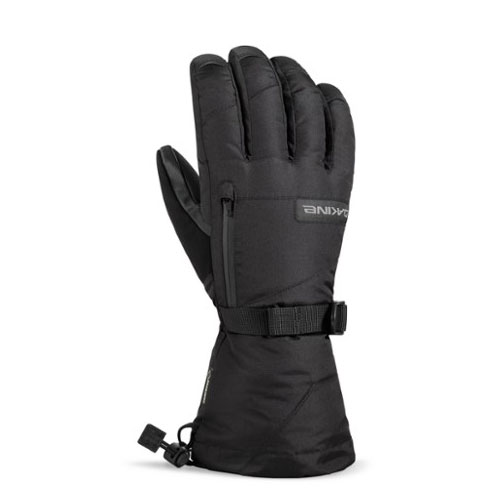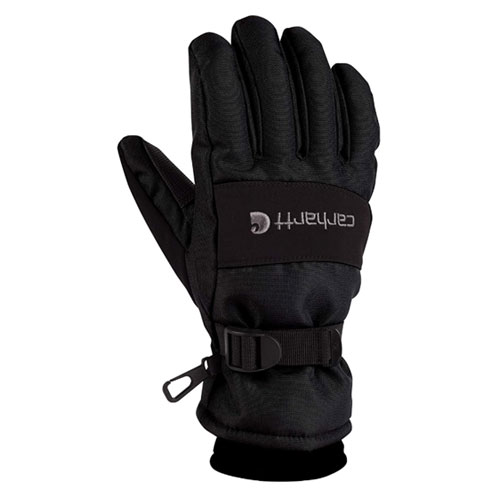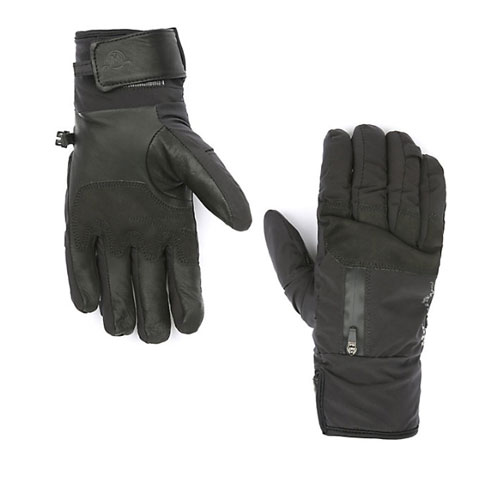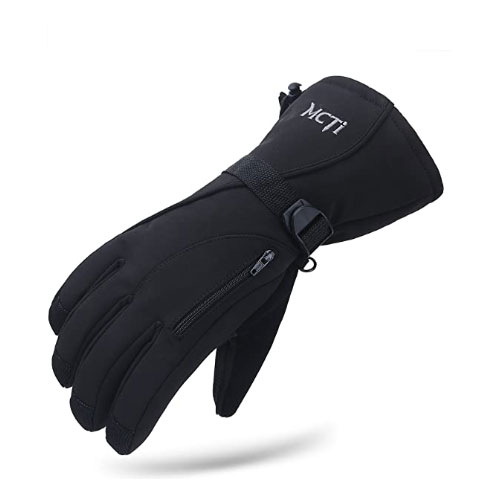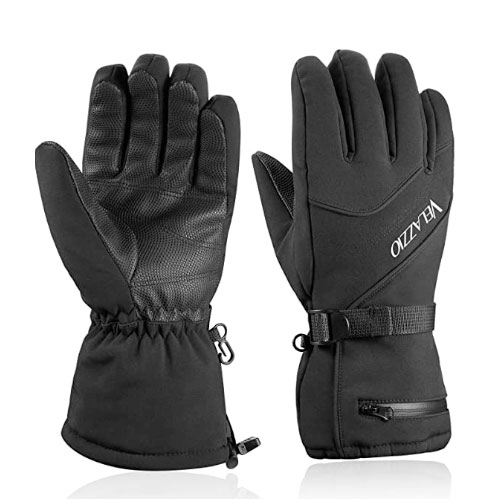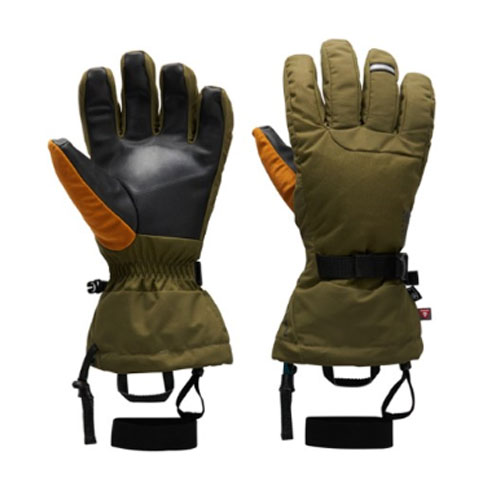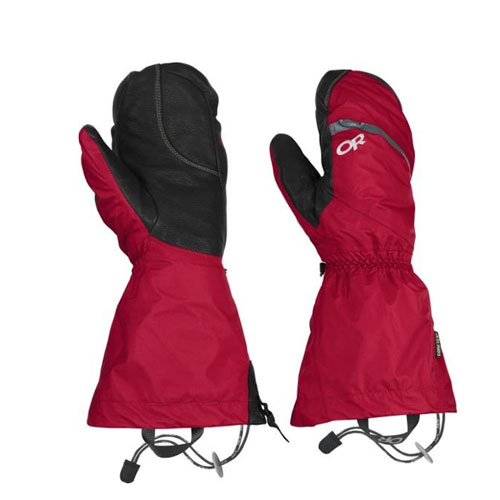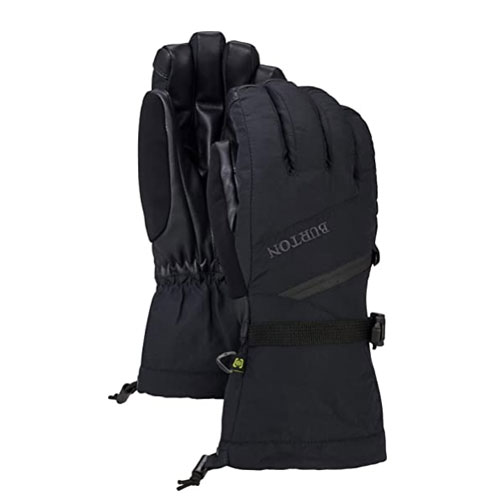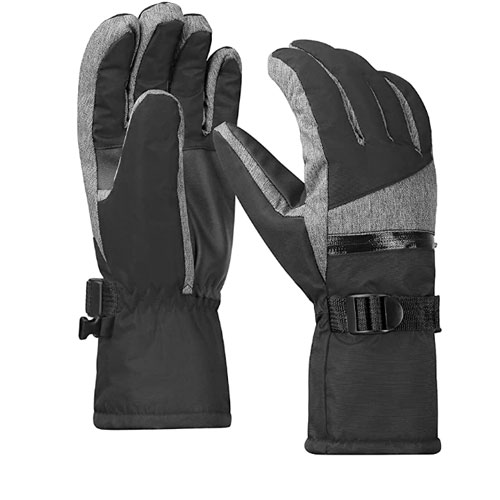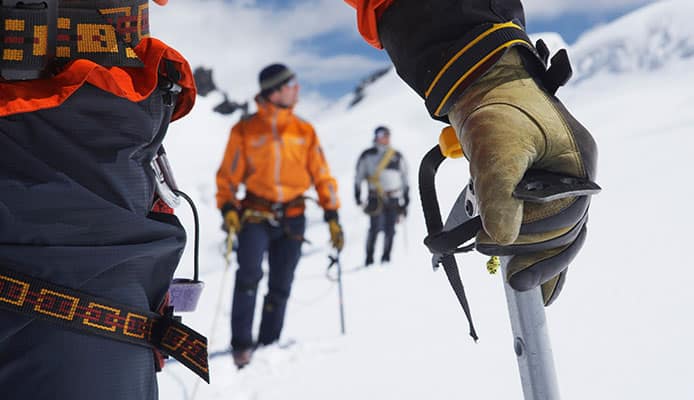
To make the most out of your day on the snow, it’s crucial that you stay dry and warm. Hands are particularly sensitive to the cold, and freezing fingers can easily ruin the fun. For this reason, everyone should take their time to find good ski gloves that can provide the necessary protection.
In this article, we’ll take a look at the best ski gloves on the market and discuss the various features they offer to the skiers. Hopefully, this will make it easier to decide which skiing gloves can give you not only the right amount of warmth, but a high level of comfort and dexterity too.
OUR TOP PICK
Black Diamond Kingpin
- Stand Out Features - Why We Love It
- Goat leather shell looks and feels fantastic
- Generous 190g fleece lining doubles as insulation
- Stretch cuff for a better fit on your wrist
- Non-slip palm provides a firm grip on any item
- Available in four different sizes and two colors
- Perfect to keep your hands warm
Shell: Goat Leather
Lining/Insulation: 190g Fleece
Waterproof: Yes
EDITORS CHOICE
DAKINE Titan Insulated
- Stand Out Features - Why We Love It
- Polyester shell with DWR for improved protection
- Lofty synthetic insulation provides all-day warmth
- Liners are easy to remove and safe for washing
- Gauntlet cuff with cinch cord keeps snow out
- Removable wrist leash so you don’t lose the gloves
Shell: Polyester with DWR
Palm: Rubbertec (100% Non-PV PVC)
Lining: 150g Tricot
Insulation: High Loft Fill (100% Polyester)
Waterproof: Yes, Gore-Tex Membrane
BEST VALUE
Carhartt Men’s W.P. Waterproof
- Stand Out Features - Why We Love It
- Strong Polytex shell allows full finger movement
- Soft lining with FastDry technology to remove sweat
- Reinforced PU palm with thumb extension for a better grip
- Undercuff design with an easily-adjustable wrist closure
- Available in five different sizes (with a size chart)
- High water resistance
Shell: Polytex (100% Polyester)
Palm: Reinforced Polyurethane (PU)
Lining: Synthetic with FastDry Technology
Insulation: Yes
Waterproof: Yes (Waterproof Insert)
- Stand Out Features - Why We Love It
- Sheepskin palm for a fantastic grip even when wet
- Mix of shell materials provides durability and comfort
- PrimaLoft insulation easily retains heat on cold days
- Velcro strap on the wrist for tightening the glove
- Waterproof pocket for warmers or smaller items
Shell: 50% Polyester, 40% Sheepskin, 10% Synthetic Leather
Palm: Sheepskin
Insulation: PrimaLoft
Waterproof: Yes (Waterproof Insert)
MCTi 3M Thinsulate Waterproof
- Stand Out Features - Why We Love It
- Triple-layer composite shell for wear-resistance
- Dual insulation keeps you warm in low temperatures
- TPU membrane prevents water from soaking in
- Reinforced fingertips improve glove durability
- Nuback palm provides a firm and secure grip
Shell: Triple-layer Composite
Palm: Nuback (Polyurethane)
Lining: Knitted Polyester
Insulation: 40g 3M Thinsulate, 140g Cotton
Waterproof: Yes (TPU Membrane)
Velazzio Waterproof Breathable
- Stand Out Features - Why We Love It
- DWR coating on the shell repels water from the surface
- Soft fleece lining provides all-day comfort
- 3M Thinsulate and cotton for keeping hands warm
- Impressive quality and warmth relative to the price
- Locking clips in the cuffs so you don’t lose the gloves
- High water resistance
Shell: Polyester with DWR
Palm: Polyurethane (PU)
Lining: Fleece
Insulation: 3M Thinsulate, Cotton
Waterproof: Yes (Fan-Tex Membrane)
- Stand Out Features - Why We Love It
- Durable 320D shell withstands heavy use
- Leather palm with touchscreen compatibility
- Gore-Tex membrane keeps water from getting in
- Long gauntlet-style cuffs with quick adjustments
- Suede nose wipes on the back of each thumb
Shell: 320D Plain-Weave Fabric with DWR
Palm: Synthetic Leather
Lining: Fleece
Insulation: PrimaLoft
Waterproof: Yes (Gore-Tex Membrane)
- Stand Out Features - Why We Love It
- Warmest ski glove for sub-zero temperatures
- Mitten design to prevent losing heat between fingers
- Gore-Tex membrane blocks water while allowing breathability
- Fully seam taped to prevent water and air from getting in
- Three-panel thumb design improves dexterity
Shell: Ripstop Nylon
Palm: Pittards Leather
Lining: Fleece
Insulation: PrimaLoft One
Waterproof: Yes (Gore-Tex Membrane)
Burton Men’s Gore-Tex
- Stand Out Features - Why We Love It
- Dual-layer DryRide shell provides durability
- Pre-curved fingers significantly improve comfort
- Lined with extra-soft brushed microfiber
- Removable Thermex liner (can be used separately)
- Multiple colors and size options available
- High water resistance
Shell: Dryride Dual-Layer Fabric
Palm: Synthetic Leather
Lining: Brushed Microfiber
Insulation: Thermacore
Waterproof: Yes (Gore-Tex Membrane)
Terra Hiker Winter
- Stand Out Features - Why We Love It
- Low-bulk design with ergonomic fingers
- TPU film and PU coating for water protection
- Zippered pocket for warmers or smaller items
- Easily adjustable wrist with webbing straps
- Snap buckle for securing the gloves together
Shell: 320D Polyester Taslan
Palm: PU Leather
Lining: Wool, Cotton
Insulation: 40g 3M Thinsulate, 140g Cotton
Waterproof: Yes
How To Choose The Best Ski Gloves – Buying Guide
Gloves vs. Mittens
When it comes to choosing the style, many skiers have a dilemma between mittens and regular skiing gloves. Each has its upsides, and there are even hybrid models that try to get the best out of both.
Gloves: They provide higher dexterity and are generally better for handling gear (opening and closing zippers, adjusting buckles, etc). However, since the fingers are separated, the hands tend to lose heat faster.
Mittens: From the warmth aspect, mittens take the prize over gloves. All fingers (except the thumb) are in the same large compartment, so there is less heat loss going on. Unfortunately, they aren’t as practical to use as standard gloves.
Lobster Gloves: This is a crossover between gloves and mittens, where the thumb and index have separate compartments, while the other three fingers are packed together. Even though this sounds nice, in reality, the performance usually isn’t that good.
Related Reviews: Women’s Ski Gloves & Ski Gloves For Kids
Insulation and Warmth
Keeping your hands warm on the track is the entire point of wearing gloves, so you should always check which type of insulation the pair of gloves have. Most models use synthetic insulation that gives you decent warmth and works even when wet. However, it can make the glove bulky.
On the other hand, down insulation provides unparalleled warmth even in freezing conditions. Unfortunately, down is pretty expensive, and loses its insulating power if it gets wet.
Waterproofing and Breathability
In addition to staying warm, your hands also need to be dry while skiing. Since no shell is completely waterproof on its own, ski gloves often come with a protective membrane (like Gore-Tex) that will keep the water out.
On top of this, your hands might get wet from your own sweat too, so make sure that all the materials are breathable and allow water vapor to escape.
You might also be interested in:
Size and Fit

If you choose the wrong glove size, everything else becomes less important. This is why all renowned manufacturers offer gloves in many different sizes, so every skier can get the right one.
The glove should fit snuggly, without being too constricting – snow and wind might get in a glove that is too large, while a small one might be very uncomfortable.
Shell Material
The shell is perhaps the most important part of the glove, as it’s responsible for both hand protection and dexterity. Most gloves are either made of natural leather or a synthetic material like nylon or polyester.
Leather: It’s a very good choice for a glove due to its natural feel. The material is really soft and follows the finger movement well. However, even though treated leather ski gloves are fairly waterproof, they can leak if exposed to water for a long time.
Synthetics: This is the way to go when it comes to water protection. While nylon is naturally water-resistant, polyester often comes with a special coating to boost the performance. On the other hand, synthetic gloves are bulkier and often less comfortable.
Lining Material
The lining inside the glove plays a huge role when it comes to the overall comfort that you’re going to get. The most popular choice for a glove liner is polyester fleece, as it provides the softness required. Unfortunately, thicker fleece might be less breathable. In this situation, wool is a great alternative that efficiently wicks sweat away and keeps your hands dry.
Cuff Length and Design
When it comes to cuffs, you have two main options – gauntlets and under cuffs. Gauntlet gloves feature cuffs that are longer and go over the sleeve of your jacket. Their advantage is an additional protection (better seal against snow) but they might reduce wrist movement.
On the other hand, under cuffs go under the sleeve of your jacket. They require a bit more time when setting up, but provide much higher wrist flexibility. However, they can get pulled out and leave your wrists exposed to snow and wind.
Additional Features
Textured (Non-Slip) Palm: Wet ski gloves can be notoriously slippery, especially if they’re made of synthetic materials. To make sure you don’t drop what you’re holding, high-end models come with palms and fingers covered with synthetic rubber (polyurethane).
Wrist Cinches/Straps: To make sure the glove sits firmly on your hand without letting any air in, you should get a model that features a cinch cord and a wrist strap with a buckle. Besides allowing you to keep snow and wind out, these also ensure that the glove stays on the hand in case you fall.
Nose Wipe: Cold weather and freezing wind will easily cause a runny nose, which can be very annoying while skiing. Of course, grabbing a tissue with gloves on isn’t very practical. This is why many models feature a nose wipe (usually on the thumb) to wipe the nose quickly.
Wrist Cords: As probably the best way to prevent losing your gloves, wrist cords can be a very valuable feature if you frequently take the gloves off. They ensure that you don’t accidentally drop the glove, which can be very tricky on the slopes.
Pockets / Vents: If you want improved temperature regulation in your gloves, getting a model with a zippered pocket is a really great idea. While mainly designed for placing hand warmers inside, they can also double as vents if your hands feel too hot.
Articulated Fingers: This can be a very useful feature, especially if you’re using a thicker pair of gloves made of stronger materials. Pre-curved fingers make gripping a ski pole much easier, so they are subsequently more comfortable to wear for prolonged periods.
Touchscreen Capability: Many modern glove designs feature a special fabric on the tips of thumb and index fingers that works with smartphone touchscreens. Since many of enjoy bringing our phones to the snow, this makes using them possible without taking the glove off.
Removable Liners: Having the option of removing your liner can go a long way when it comes to maintenance. This allows you to pull the liner out and dry it if the glove gets sweaty, and also to use the liner and the shell separately in changing weather conditions.
FAQs
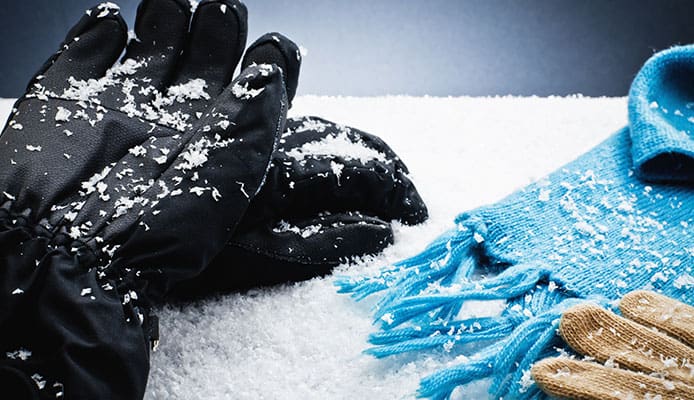
Q: Are Gloves Or Mittens Better For Skiing?
We can’t say outright, as this depends on your preferences as a skier. If you’re after warmth, mittens are the option for you as they keep your fingers together and retain their warmth. However, they aren’t really good for grabbing things other than your ski pole. A skiing glove has the fingers separated for higher versatility, but it cools down faster.
Q: Are Leather Gloves Better Than Other Ski Gloves?
This depends on what you need on the track, as these materials offer slightly different qualities. Leather ski gloves feel natural and allow unrestricted finger movement, but can let water in if it gets soaked. On the other hand, other gloves are made of synthetic materials that offer better water protection but often aren’t as soft and comfortable.
Q: What Are Liner Gloves And Should I Use Them?
Liner gloves are special thin gloves that you wear under your standard ski gloves. Their main purpose providing some additional warmth, which is especially useful in very cold weather. Additionally, they might also help wick away moisture and keep your hands dry.
Q: What Is A Hand Warmer Pocket?
These are small pockets located on the back of your hand, designed to fit small hand warmer packs that can provide some additional warmth. They can have a much wider use though, as you can even use them for stashing money and other small items.
Globo Surf Overview
Whether you prefer mittens or a traditional pair of gloves, under cuff or gauntlet, there are plenty of things to consider when looking for a ski glove. Putting some thought into the process will reward you greatly, and we hope that our reviews and guide pointed you in the right direction. With the most efficient ski gloves from our list, you’ll never have to worry about cold fingers again.
More Snow Ski Gear Reviews:
- Ski Locks
- Ski Goggles For Flat Light
- Kids Ski Goggles
- Ski Walkie Talkies
- Ski Helmet Headphones
- Ski Carry Straps
- Ski Helmets With Visors
- Ski Boots For Wide Feet
- OTG Ski Goggles
- Sunglasses For Skiing
- Kids Ski Pants
- Night Skiing Goggles
- Ski Mid-layers
- Base Layers For Skiing
- Ski Racks
- Skis For Beginners
- Ski Bags
- Gifts For Skiers And Snowboarders
- Avalanche Shovels


